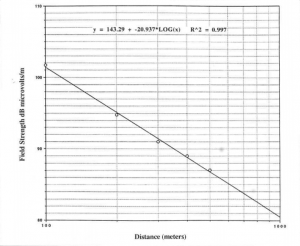(Belrose 1998) described a mobile antenna system which, to his credit, the author validated its performance by making a series of field strength measurements and calculating radiation efficiency.
It appears that Belrose has assumed the antenna is omni directional for ground wave, though he shows that for higher angle space wave it is not omni directional.
Belrose’s measurement and calculation
Above, Belrose gives a set of measurements of field strength at different distances, and a curve fit from which he takes a value of 101.42dBµV/m at 100m as the basis for his efficiency calculation. Continue reading Belrose field strength measurements of his 80m mobile whip




